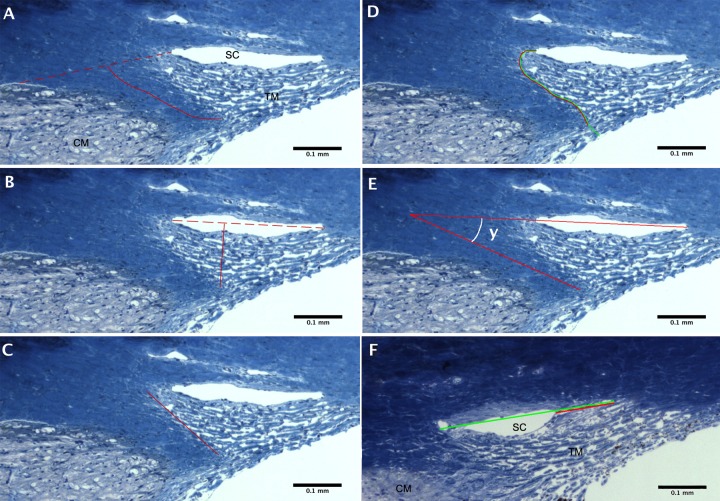Figure 1.
Methods for measurements. (A–C) Measurements of the scleral spur length. Three methods were used to measure the scleral spur length, as shown in a 72-year-old normal eye. In our method (A) the solid line represents scleral spur length, drawn from the tip of the scleral spur to the middle of the red dotted line, which connects the anterior and posterior points where the sclera curves out to form the spur. In the method of Nesterov and Batmanov8 (B) the measurement was taken from the level of the anterior base of the scleral spur, directly to the level of the posterior end of SC. In the method of Moses and Arnzen20 (C) scleral spur length was measured by the red, solid line from the tip of the scleral spur to the level of the posterior end of SC, along the anterior side of the scleral spur. (D) Measurement of the ratio of TM insertion into the scleral spur to the total posterior height of TM, shown in the same eye as in (A–C). The red line represents the length of TM insertion in the scleral spur; the green line represents the total posterior height of TM from the anterior chamber to SC. (E) Measurement of the angle between the scleral sulcus and the scleral spur shown in the same eye as in (A–D). A straight, red line through the anterior and posterior ends of SC was drawn to designate the scleral sulcus as outlined by Grierson et al.15 The straight, red line from the tip of the scleral spur was drawn to designate the axis of the scleral spur and to identify the desired angle. The curved line indicates angle measured. (F) Measurement of the percentage of collapse of SC, shown in a POAG eye. The red line represents the width of SC collapse; the green line represents the total width of SC.

